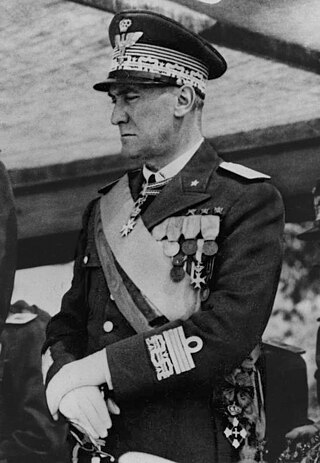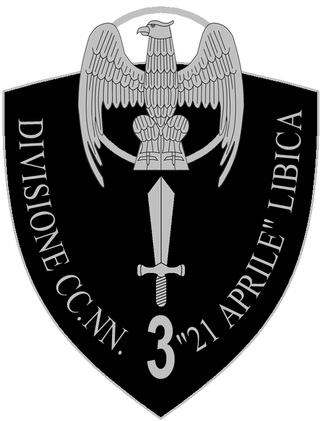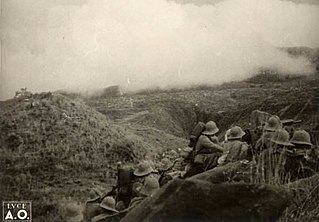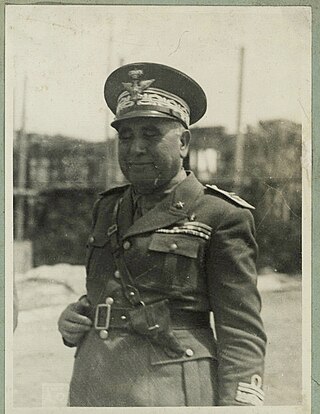Related Research Articles

Rodolfo Graziani, 1st Marquis of Neghelli, was a prominent Italian military officer in the Kingdom of Italy's Royal Army, primarily noted for his campaigns in Africa before and during World War II. A dedicated fascist and prominent member of the National Fascist Party, he was a key figure in the Italian military during the reign of Victor Emmanuel III.

The Abyssinia Crisis, also known in Italy as the Walwal incident, was an international crisis in 1935 that originated in a dispute over the town of Walwal, which then turned into a conflict between the Fascist-ruled Kingdom of Italy and the Ethiopian Empire. The League of Nations ruled against Italy and voted for economic sanctions, but they were never fully applied. Italy ignored the sanctions, quit the League, made special deals with the United Kingdom and France and ultimately annexed and occupied Abyssinia after it had won the Second Italo-Ethiopian War. The crisis is generally regarded as having discredited the League.

The Second Italo-Ethiopian War, also referred to as the Second Italo-Abyssinian War, was a war of aggression which was fought between Italy and Ethiopia from October 1935 to February 1937. In Ethiopia it is often referred to simply as the Italian Invasion, and in Italy as the Ethiopian War. It is seen as an example of the expansionist policy that characterized the Axis powers and the ineffectiveness of the League of Nations before the outbreak of the Second World War.
Italo-Ethiopian War, Italo-Abyssinian War or Italian invasion of Ethiopia / Abyssinia may refer to:

Emilio De Bono was an Italian general, fascist activist, marshal, war criminal, and member of the Fascist Grand Council. De Bono fought in the Italo-Turkish War, the First World War and the Second Italo-Abyssinian War. He was one of the key figures behind Italy's anti-partisan policies in Libya, such as the use of poison gas and concentration camps, which resulted in the deaths of tens of thousands of civilians and have been described as genocidal.

The Royal Italian Army (RE) was the land force of the Kingdom of Italy, established with the proclamation of the Kingdom of Italy. During the 19th century Italy started to unify into one country, and in 1861 Manfredo Fanti signed a decree creating the Army of the Two Sicilies. This newly created army's first task was to defend against the repressive power in southern Italy, exemplified by rulers like Francis II of the Two Sicilies. The Army of the Two Sicilies combated against outlaws and against other armies during this time of unification. After the monarchy ended in 1946, the army changed its name to become the modern Italian Army.

The Second Battle of Tembien was a battle fought on the northern front of the Second Italo-Ethiopian War. This battle consisted of attacks by Italian forces under Marshal Pietro Badoglio on Ethiopian forces under Ras Kassa Haile Darge and Ras Seyoum Mangasha. This battle, which resulted in a decisive defeat of Ethiopian forces, was primarily fought in the area around the Tembien Province. The battle is notable for the large-scale use of mustard gas by the Italians.

The 3rd CC.NN. Division "21 Aprile" was an Italian CC.NN. division raised on 10 June 1935 for the Second Italo-Ethiopian War against Ethiopia and disbanded shortly before Italy's entry into World War II. The name "21 Aprile" was chosen to commemorate the legendary date of the founding of Rome.
The First Battle of Tembien was a battle fought on the northern front of what was known as the Second Italo-Ethiopian War. This battle consisted of attacks and counterattacks by Italian forces under Marshal Pietro Badoglio and Ethiopian forces under Ras Kassa Haile Darge. This battle was primarily fought around Worsege Pass in what was then the Tembien Province of Ethiopia.

The Battle of Amba Aradam was a battle fought on the northern front of what was known as the Second Italo-Abyssinian War. This battle consisted of attacks and counter-attacks by Italian forces under Marshal of Italy Pietro Badoglio and Ethiopian forces under Ras Mulugeta Yeggazu. This battle was primarily fought in the area around Amba Aradam which included most of Enderta Province.

The Battle of Shire was a battle fought on the northern front of what was known as the Second Italo-Abyssinian War. This battle consisted of attacks and counterattacks by Italian forces under Marshal of Italy Pietro Badoglio and Ethiopian forces under Ras Imru Haile Selassie. This battle was primarily fought in the Shire area of Ethiopia.
The Battle of the Ogaden was fought in 1936 in the southern front of the Second Italo-Abyssinian War. The battle consisted of attacks by the Italian forces of General Rodolfo Graziani, the commander-in-chief of the forces on the "southern front", against Ethiopian defensive positions commanded by Ras Nasibu Emmanual. The strong defensive positions were designed by Wehib Pasha and known as the "Hindenburg Wall". The battle was primarily fought to the south of Harar and Jijiga.

The Christmas Offensive took place during the Second Italo-Ethiopian War. The Ethiopian offensive was more of a counteroffensive to an ever-slowing Italian offensive which started the war.

Amhara Governorate was one of the six governorates of Italian East Africa. Its capital was Gondar. It was formed in 1936 from parts of the conquered Ethiopian Empire following the Second Italo-Ethiopian War. It had a population of more than 2 million inhabitants. In November 1938 some territory of Amhara in the Scioa region was given to the neighboring Addis Abeba Governorate, enlarging it to the Scioa Governorate.

Ethiopia–Italy relations are the current and historical relations between Ethiopia and Italy.

The Gondrand massacre was a 1936 Ethiopian attack on Italian workers of the Gondrand company. It was publicized by Fascist Italy in an attempt to justify its ongoing conquest of Ethiopia.

Ruggero Santini was an Italian general. He was the colonial governor of Somaliland. He fought in the First Italo-Ethiopian War and Italo-Turkish War. In World War I he fought against Austria-Hungary.

A bust of the Ethiopian emperor Haile Selassie formerly stood in Cannizaro Park in Wimbledon Common, London. A work of the sculptor Hilda Seligman, it was destroyed in June 2020.
References
- ↑ "Small Arms Archives". Comando Supremo. Retrieved 2021-08-04.